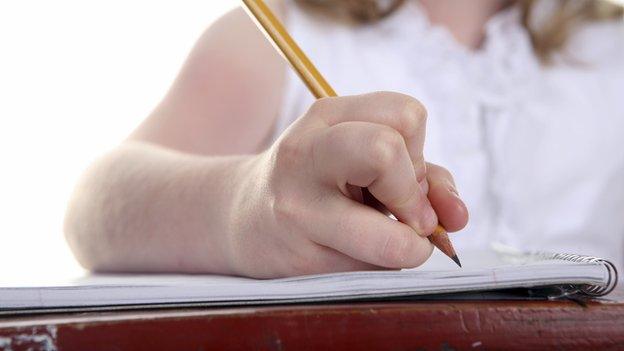Scottish education: The return of standardised testing?
- Published

The Scottish government has revealed more details on how it plans to raise attainment in schools.
Unveiling her legislative programme for the coming year, First Minister Nicola Sturgeon said new national, standardised assessments would be brought in for pupils in primaries one, four and seven, and in S3.
Ms Sturgeon said she did not want to create "crude league tables", but that more information needed to be made available about performance in primary and lower secondary school.
National testing for five to 13-year-olds was scrapped in Scotland in 2003 by the Labour-Lib Dem coalition led by Jack McConnell.
Different systems of assessment are used across Scotland's 32 council areas.
The phrase national testing has not been used by the Scottish government - but standardising the assessment process for primary school and early secondary school students would mark a return to a form of national testing.
Top priority
The move could prove controversial, and unions have already put a shot across the government's bows - but much of the devil will actually be in the detail.
The Scottish government sees raising attainment in schools as a top priority. One problem it faces is the quality of the data on primary school performance.
There is often very good data available at a purely local level but it can be hard to get a sense of the overall national picture or compare how well a school in one area is doing with a school somewhere else.
One of the best indicators of the performance of children across Scotland comes in the biannual national surveys of numeracy and literacy - in which a cross section of children in P4, P7 and S2 are tested.
While these surveys can give a good indication of the performance of youngsters across Scotland as a whole there is no data for individual schools or council areas.
The literacy survey published this year suggested some drops in performance.
Currently 30 of Scotland's 32 councils use a form of standardised assessment for primary and lower secondary pupils. They use different systems, however, meaning forming a national picture on attainment is difficult.
One issue with standardising assessments is whether they will result in any extra workload for teachers and students or simply mean modifications to the assessments currently carried out.
Another gets to the nub of changes to education in recent years. Curriculum for Excellence is meant to place less emphasis on testing and formal assessment.
League table
The issue of league tables also raises its head - the presentation of data in such a way as to suggest that the better a school's performance in the assessments, the better the school is itself.
Unions, the Scottish government and many within the profession in Scotland agree there is more to a school's performance than raw data alone - particularly the demographics of the school's catchment area. The argument is that schools in suburban areas with relatively good results may actually be coasting while some in deprived areas with relatively poor results may actually be doing well.
The Scottish government will publish the data from the standardised assessments but will not present it in league table form - however, with the data in the public domain, there is nothing to stop journalists and others from producing tables.
Unions will want reassurances about how the data will actually be used by policymakers.
Another potential area of controversy goes beyond the purely educational arguments. Councils are very protective of their role in the education service but some in local government argue there has been a process of creeping centralisation within Scotland over many years.
Some non-SNP councils may see standardised assessments through this prism.